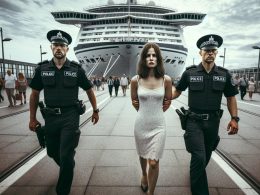The Titanic was built in 1909, and we’re still discussing it today. However, we often discuss it for its failures more than its successes. So, how does the Titanic compare to modern cruise ships?
Today, we will examine how this famous ship would compare if it went toe-to-toe with modern cruise ships. Interestingly, the results might surprise you.
Let’s climb aboard and get started!
Is It Fair to Compare Titanic to Modern Cruise Ships?
Unfortunately, putting the Titanic against modern cruise ships is not a fair comparison. It’s been over 100 years since the Titanic was constructed and set sail.
Technology advancements have come a long way over the past century. Manufacturers today have a distinct advantage that wasn’t available to previous builders.
Even a middle-of-the-road cruise ship today is far superior to the Titanic. By saying this, we mean no disrespect to the impressiveness of Titanic.
However, it would be dishonest to say it was in the same class as modern ships.

Are Modern Cruise Ships Safe?
Because of accidents like the Titanic, modern ships must follow stringent safety regulations. It’s more than just smoke and leak detectors. Safety is of the utmost importance at every step in constructing modern rigs.
Modern ships have watertight compartments, required safety drills, advanced fire detection systems, and sophisticated security and surveillance systems. Passenger cruise lines have strategic emergency response plans that are well-developed and thought out. They prepare for medical emergencies, severe weather, and various mechanical failures.
Luckily, manufacturers learned from previous mistakes. They’ve been able to craft cruise ships that are powerful, capable, and able to provide a smoother and safer experience for passengers and crew.
HOT TIP
How Likely Is It to Get Seasick on a Cruise? Click to find out.
Titanic vs. Modern Cruise Ships
So, while it may not be fair, let’s compare the Titanic to modern cruise ships. Some of the comparisons are shocking in terms of how different the two vessels are.
Size and Capacity
The Titanic was the largest and most luxurious ship of its time. It was 882 feet long and had a gross tonnage of approximately 46,000 tons.
However, modern cruise ships are over 1,000 feet long and have a gross tonnage of over 200,000 tons.
Additionally, the Titanic had 840 staterooms and could accommodate 2,435 passengers and its crew of 892 members. Cruise ships today can accommodate 3,000 to 7,000 passengers and have crews of more than 2,000.
Modern cruise ships would dwarf Titanic if they were next to each other in the water.

Construction and Materials
The Titanic was built in 1909 and completed in 1912. Construction was primarily of steel plates getting riveted together. They divided the hull into 16 watertight compartments designed to help stabilize and increase safety for the ship.
Technology has advanced, and modern steel is much more capable and durable. Manufacturers use computer-aided design and welding methods that are precise.
The materials are better able to withstand the stresses at sea and the pressures that ocean travel requires.
Safety Features and Regulations
The Titanic had safety features like lifeboats. However, there were only enough lifeboats to accommodate a fraction of the passengers and crew onboard. In addition, many of the staff hadn’t received training to handle an emergency.
Today, passengers and crew must participate in drills and exercises before they can set sail. In addition, ships have life-saving equipment, life vests, and life rafts to accommodate all passengers and crew onboard.
All crew members are trained to respond to various emergencies so that accidents like the sinking of Titanic never happen again.

Titanic relied on celestial navigation techniques, which means the ship’s position was calculated using the stars. Communication with vessels and other land-based stations was via wireless telegraphy. After impacting with an iceberg, the ship communicated its distress signals using Morse code.
Thankfully, modern ships come with the most sophisticated navigation technologies in history. They use Global Positioning System (GPS) satellites to communicate their positions constantly.
Many ships have advanced radar, digital navigation charts, weather forecasting, and other high-tech features. They are better able to predict ocean conditions and make adjustments in their route to avoid situations.

Power Source
If you’ve seen the movie Titanic, you likely saw the workers shoveling coal into the boilers to produce steam to drive the engines. The Titanic used 29 coal-fired boilers to power the two engine rooms. The steam then went out of the boilers to turn the propellers.
Today, ships use diesel engines. Not only are they more powerful and efficient, but they’re also friendlier to the environment.
Some even take it further and have hybrid propulsion and pod propulsion systems. These allow ships to rotate 360 degrees, which reduces their dependence on rudders and provides enhanced control.
HOT TIP
Did you know Cruise Prices Are Higher Than Ever?
Amenities
Regarding amenities, the first-class passengers on Titanic had the most elegant dining rooms, lounges, and a smoking room. In addition, there was a gymnasium, a Turkish bath, and a squash court.
Those that were second-class had less comfortable accommodations but had a dining facility. However, third-class passengers had multi-purpose communal spaces.
If you’ve stepped on board a cruise ship today, passengers of all levels get a wide range of amenities. There are swimming pools, theaters, plenty of dining options, spa facilities, and sports and recreation options.
Some of the newest ships even come with Wi-Fi, allowing passengers to stream shows and video chat with friends and family back home.

Modern Cruise Ships Dwarf Titanic
Unfortunately, putting the Titanic up against modern cruise ships is not a fair comparison. The Titanic was a state-of-the-art piece of machinery for its time.
However, we’ve come a long way in safety and technological advancements. You can cruise safely now, knowing there’s little chance of something going wrong. If it does, the crew likely has a plan for responding.










